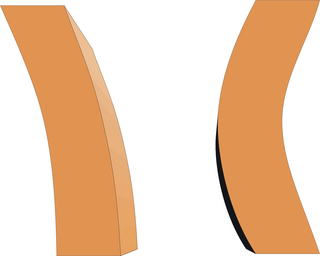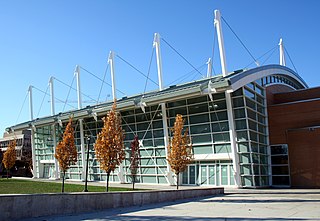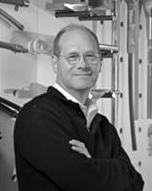Related Research Articles

A response spectrum is a plot of the peak or steady-state response of a series of oscillators of varying natural frequency, that are forced into motion by the same base vibration or shock. The resulting plot can then be used to pick off the response of any linear system, given its natural frequency of oscillation. One such use is in assessing the peak response of buildings to earthquakes. The science of strong ground motion may use some values from the ground response spectrum for correlation with seismic damage.

Seismic analysis is a subset of structural analysis and is the calculation of the response of a building structure to earthquakes. It is part of the process of structural design, earthquake engineering or structural assessment and retrofit in regions where earthquakes are prevalent.

Earthquake engineering is an interdisciplinary branch of engineering that designs and analyzes structures, such as buildings and bridges, with earthquakes in mind. Its overall goal is to make such structures more resistant to earthquakes. An earthquake engineer aims to construct structures that will not be damaged in minor shaking and will avoid serious damage or collapse in a major earthquake. Earthquake engineering is the scientific field concerned with protecting society, the natural environment, and the man-made environment from earthquakes by limiting the seismic risk to socio-economically acceptable levels. Traditionally, it has been narrowly defined as the study of the behavior of structures and geo-structures subject to seismic loading; it is considered as a subset of structural engineering, geotechnical engineering, mechanical engineering, chemical engineering, applied physics, etc. However, the tremendous costs experienced in recent earthquakes have led to an expansion of its scope to encompass disciplines from the wider field of civil engineering, mechanical engineering, nuclear engineering, and from the social sciences, especially sociology, political science, economics, and finance.

Nathan Mortimore Newmark was an American structural engineer and academic, who is widely considered as one of the founding fathers of Earthquake Engineering. He was awarded the National Medal of Science for engineering.

National Center for Research on Earthquake Engineering is an organisation in Da'an District, Taipei, Taiwan.
Ground–structure interaction (SSI) consists of the interaction between soil (ground) and a structure built upon it. It is primarily an exchange of mutual stress, whereby the movement of the ground-structure system is influenced by both the type of ground and the type of structure. This is especially applicable to areas of seismic activity. Various combinations of soil and structure can either amplify or diminish movement and subsequent damage. A building on stiff ground rather than deformable ground will tend to suffer greater damage. A second interaction effect, tied to mechanical properties of soil, is the sinking of foundations, worsened by a seismic event. This phenomenon is called soil liquefaction.

Earthquake-resistant or aseismic structures are designed to protect buildings to some or greater extent from earthquakes. While no structure can be entirely immune to damage from earthquakes, the goal of earthquake-resistant construction is to erect structures that fare better during Seismic activity than their conventional counterparts. According to building codes, earthquake-resistant structures are intended to withstand the largest earthquake of a certain probability that is likely to occur at their location. This means the loss of life should be minimized by preventing collapse of the buildings for rare earthquakes while the loss of the functionality should be limited for more frequent ones.

Architectural engineering, also known as building engineering or architecture engineering, is an engineering discipline that deals with the technological aspects and multi-disciplinary approach to planning, design, construction and operation of buildings, such as analysis and integrated design of environmental systems, structural systems, behavior and properties of building components and materials, and construction management.

William Frazier Baker, also known as Bill Baker, is an American structural engineer known for engineering the Burj Khalifa, the world's tallest building/man-made structure. He is currently a structural engineering partner in the Chicago office of Skidmore, Owings & Merrill, LLP (SOM).

C. (Carl) Allin Cornell was a civil engineer, a researcher, and a professor who made important contributions to reliability theory and earthquake engineering and, along with Dr. Luis Esteva, developed the field of Probabilistic Seismic Hazard Analysis in 1968.
The Field Act was one of the first pieces of legislation that mandated earthquake-resistant construction in the United States. The Field Act had its genesis in the 6.3 magnitude 1933 Long Beach earthquake which occurred on March 10 of that year and destroyed or rendered unsafe 230 school buildings in Southern California.
A braced frame is a structural system designed to resist wind and earthquake forces. Members in a braced frame are not allowed to sway laterally.
Michel Soto Chalhoub is a civil engineer who pioneered modern practice in shock, vibration, and seismic design using energy dissipating devices [ref]. He developed his methodologies while at the University of California, Berkeley, where he earned his Ph.D. in dynamics and seismic design.

Ashraf Habibullah is a Pakistani-American structural engineer and software developer best known as the founder, President, and CEO of Computers and Structures, Inc., a structural and earthquake engineering software company based in Berkeley, California. Upon founding the privately held company in 1975, Ashraf co-created the first structural-engineering software available to the personal computer, and has since created a suite of products, and developed their capabilities. Notably, ETABS, a multi-story building analysis and design software, received recognition as the Applied Technology Council and Engineering News-Record Top Seismic Product of the 20th Century.
Seismic codes or earthquake codes are building codes designed to protect property and life in buildings in case of earthquakes. The need for such codes is reflected in the saying, "Earthquakes don't kill people—buildings do." Or in expanded version, “Earthquakes do not injure or kill people. Poorly built manmade structures injure and kill people.”

Michael John Nigel Priestley was a New Zealand earthquake engineer. He made significant contributions to the design and retrofit of concrete structures, and developed the first displacement-based method of seismic design.
Anand Swarup Arya (1931-2019) was an Indian structural engineer, known for his expertise in the soil and foundation engineering and earthquake disaster management.He is a former chairman of the Bureau of Indian Standards (BIS) Committee on Earthquake Engineering and a recipient of the United Nations Sasakawa Disaster Prevention Award of 1997. The Government of India awarded him the fourth highest civilian honour of the Padma Shri in 2002.

Contained earth (CE) is a structurally designed natural building material that combines containment, inexpensive reinforcement, and strongly cohesive earthen walls. CE is earthbag construction that can be calibrated for several seismic risk levels based on building soil strength and plan standards for adequate bracing.
Andrew Stuart Whittaker is an American structural engineer who is currently a SUNY Distinguished Professor in the Department of Civil, Structural and Environmental Engineering at the University at Buffalo, State University of New York.
Sudhir K. Jain is a civil engineer and professor at Indian Institute of Technology Gandhinagar. He is currently serving his third term as the director of the Indian Institute of Technology Gandhinagar. He has been carrying out intensive resrearch and development in the fields of Seismic Design Codes, Dynamic of Buildings and Post Earthquake Studies. Beside these, Prof. Jain has actively participated in teaching, research activities and development in Earthquake Engineering focused on developing countries. He is an elected fellow of Indian National Academy of Engineering. He has served on the Engineering and Computer Science jury for the Infosys Prize from 2019. He has also served as the president of International Association of Earthquake engineering (IAEE) from 2014 to 2018.
References
- ↑ "Origin and History". Structural Engineers Association of Northern California. Retrieved 2018-01-04.
- ↑ Diebold, J.; Moore, K.; Hale, T.; Mochizuki, G. (October 12–17, 2008). "SEAOC Blue Book: Seismic Design Recommendations 1959 to 2008" (PDF). Proceedings of the 14th World Conference on Earthquake Engineering. Beijing, China. Retrieved 2010-08-15.